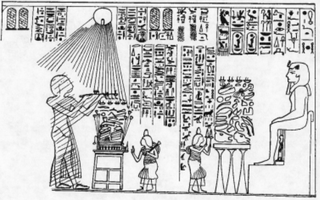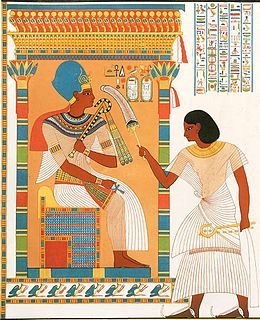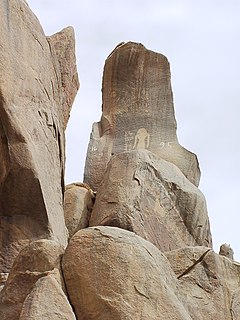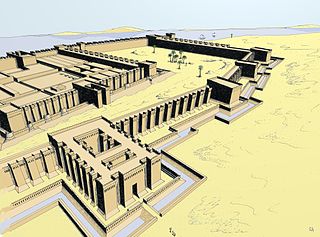
Amenhotep III, also known as Amenhotep the Magnificent, was the ninth pharaoh of the Eighteenth Dynasty. According to different authors, he ruled Egypt from June 1386 to 1349 BC, or from June 1388 BC to December 1351 BC/1350 BC, after his father Thutmose IV died. Amenhotep III was Thutmose's son by a minor wife, Mutemwiya.
Thutmose is an Anglicization of the Egyptian name dhwty-ms, usually translated as "Born of the god Thoth". It may refer to several individuals from the 18th Dynasty:

Ay was the penultimate Pharaoh of Ancient Egypt's 18th dynasty. He held the throne of Egypt for a brief four-year period, although he was a close advisor to two and perhaps three of the pharaohs who ruled before him and is thought to have been the power behind the throne during Tutankhamun's reign. Ay's prenomen or royal name—Kheperkheperure—means "Everlasting are the Manifestations of Ra" while his birth name Ay it-netjer reads as "Ay, Father of the God". Records and monuments that can be clearly attributed to Ay are rare, not only due to his short length of reign, but also because his successor, Horemheb, instigated a campaign of damnatio memoriae against him and other pharaohs associated with the unpopular Amarna Period.

Bek or Bak was the first chief royal sculptor during the reign of Pharaoh Akhenaten. His father Men held the same position under Akhenaten's father Amenhotep III; his mother Roi was a woman from Heliopolis.
Ahmose called Turo was Viceroy of Kush under Amenhotep I and Thutmose I.

Merymose, also Mermose or Merimes, was a Viceroy of Kush under Amenhotep III. He served for almost the entire four decades of that reign.

Amenhotep called Huy was Viceroy of Kush under Tutankhamen. He was the successor of Tuthmosis, who served under Akhenaten. He would later be succeeded by Paser I.

Amenemopet served as Viceroy of Kush during the reign of Seti I.
Heqanakht was Viceroy of Kush during the reign of Ramesses II. His titles include: King's son of Kush, overseer of the Southern Lands, Fan-bearer on the Right Side of the King, Messenger to every land, Hereditary prince, royal sealbearer.
Paser II was the son of the High Priest of Min and Isis named Minmose. Paser came from a very well-connected family. One uncle was the High Priest of Amun Wennenefer and another uncle was the troop commander of Kush named Pennesuttawy. Through Wennenefer, Paser was related to Amenemone, Amenemope and Hori, the High Priest of Anhur.
Huy was Viceroy of Kush during the reign of Ramesses II. He may have served either before or after Setau. Huy was also Mayor of Tjarw and a royal messenger to the Hatti.
Paser I was the Viceroy of Kush during the reigns of Ay and likely Horemheb. Reisner mentions that the only datable inscriptions for Paser belong to the reign of Ay. The next known Viceroy however is Amenemopet, who is dated to the reign of Seti I. Hence it's possible that Paser I served during the reigns of Ay, Horemheb

The Viceroy of Kush Seti is attested in year 1 of Siptah. Seti is also mentioned on some monuments of his son Amenemhab. Amenemhab was the son of Seti and the Lady Amenemtaiauw. Seti held the titles fan-bearer on the king's right, and king's scribe of the letters of the Pharaoh. His son Amenemheb served as Head Bowman, Charioteer of His Majesty, and Overseer of the Southern Lands.
Hori II is a son of Hori I and also served as Viceroy of Kush. Their tombs have been found in Tell Basta. Hori II may have been the father of a later Viceroy named Wentawat.

Wentawat, was Viceroy of Kush under Ramesses IX, during the 20th Dynasty. He was a son of the Viceroy Nahihor.

The Theban Tomb TT383 is located in Qurnet Murai, part of the Theban Necropolis, on the west bank of the Nile, opposite to Luxor. It is the burial place of the Ancient Egyptian Viceroy of Kush named Merymose, who lived during the 18th and served under Amenhotep III.

Usersatet was an Ancient Egyptian official with the titles king's son of Kush and overseer of the southern countries. He was in office under king Amenhotep II and perhaps in the early years of the reign of Thutmosis IV. As king's son of Kush he was the main official in charge of the Nubian provinces.
Amenhotep was an Ancient Egyptian official with the title king's son of Kush. In this function he was the main administrator of the Nubian provinces. Amenhotep was in office under Thutmosis IV. He appears with his main title in a rock inscription on the island of Sehel. Here he also bears the titles overseer of the cattle of Amun, overseer of works in Upper and Lower Egypt, chief of the stalls of his majesty, overseer of the southern foreign lands and king's scribe. The inscription is not dated by a king's name. However, there is a stela in the Ashmolean Museum in Oxford belonging to a king's son, overseer of the cattle of Amun and confident of Kush, perhaps belonging to the same person. The stela shows the names of king Thutmosis IV. In case both monuments belong to the same person, Amenhotep was in office under this king. Amenhotep is also known from a statue found at Deir el Medineh.
Nakhtmin or Minnakht is the name of several Ancient Egyptian Officials












